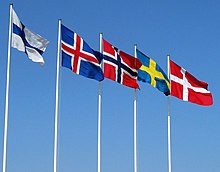

Larger flags, from left to right: Iceland, Faroe Islands, Denmark, Norway, Sweden, Finland;
Smaller flags, from left to right: Barra, South Uist, Yorkshire West Riding (historical), Orkney, Shetland, Scania, Åland, Pärnu, Setomaa (ethnic), Vepsians (ethnic).
A Nordic cross flag is a flag bearing the design of the Nordic or Scandinavian cross, a cross symbol in a rectangular field, with the centre of the cross shifted towards the hoist.
All independent Nordic countries have adopted such flags in the modern period, and while the Nordic cross is named for its use in the national flags of the Nordic nations, the term is used universally by vexillologists, in reference not only to the flags of the Nordic countries but to other flags with similar designs.[1] The cross design represents Christianity,[2][3][4] and was first seen in the Dannebrog, the national flag of Denmark in the first half of the 13th century. The same design, but with a red Nordic cross on a yellow background, was used as union flag during the Kalmar union (1397 to 1523), and when that union fell apart in 1523 the same design, but with a yellow cross on a blue background (derived from the Swedish coat of arms adopted in 1442), was adopted as national flag of Sweden, while Norway adopted their flag in 1821. From its adoption in the early 16th century until 1906 the background of the flag of Sweden was dark blue, but was changed to the currently used lighter shade of blue in a new flag law that was adopted in 1906, after the dissolution of the union between Sweden and Norway. After gaining independence the other Nordic countries adopted national flags of the same design, Iceland in 1915 and Finland in 1918. The Norwegian flag was the first Nordic cross flag with three colours. All Nordic flags may be flown as gonfalons as well.
- ^ EnchantedLearning.com Archived 3 December 2017 at the Wayback Machine; Historical flags of the world: The Scandinavian cross Archived 2 September 2020 at the Wayback Machine; Eric Inglefield: "Fahnen und Flaggen" (translated to German by Dagmar Hahn), Delphin Verlag, Munich 1986, p.16
- ^ Jeroen Temperman (2010). State Religion Relationships and Human Rights Law: Towards a Right to Religiously Neutral Governance. Martinus Nijhoff Publishers. p. 88. ISBN 978-9004181489. Archived from the original on 23 April 2023. Retrieved 31 December 2007.
Many predominantly Christian states show a cross, symbolising Christianity, on their national flag. The so-called Scandinavian crosses or Nordic crosses on the flags of the Nordic countries–Denmark, Finland, Iceland, Norway and Sweden–also represent Christianity.
- ^ Carol A. Foley (1996). The Australian Flag: Colonial Relic or Contemporary Icon. William Gaunt & Sons. ISBN 9781862871885. Archived from the original on 23 April 2023. Retrieved 31 December 2007.
The Christian cross, for instance, is one of the oldest and most widely used symbols in the world, and many European countries, such as the United Kingdom, Norway, Sweden, Finland, Denmark, Iceland, Greece and Switzerland, adopted and currently retain the Christian cross on their national flags.
- ^ Andrew Evans (2008). Iceland. Bradt. ISBN 9781841622156. Archived from the original on 23 April 2023. Retrieved 31 December 2007.
Legend states that a red cloth with the white cross simply fell from the sky in the middle of the 13th-century Battle of Valdemar, after which the Danes were victorious. As a badge of divine right, Denmark flew its cross in the other Scandinavian countries it ruled and as each nation gained independence, they incorporated the Christian symbol.